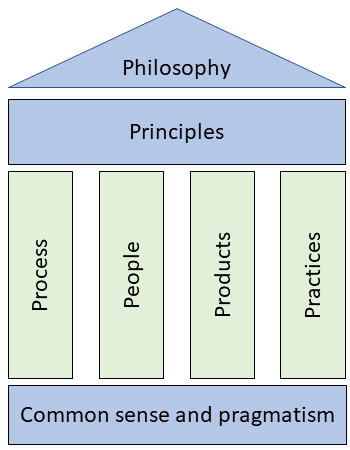
Origins
The Dynamic Systems Development Method (DSDM) is frequently thought of as an undiscovered jewel in the Agile sphere.Debuted in 1995, DSDM has the most extensive history among Agile methods and is the only method that concentrates on managing Agile projects.
In the years post-2000, DSDM rose in popularity among software developers who were exploring alternatives to rapid application development (RAD) methodologies. A major constraint of RAD was its limited scalability for team collaboration. DSDM tackled this issue by fostering collaboration within teams and at scale, making it one of the initial Agile methodologies adopted by the software development community.
DSDM participated in the inception of the Agile Alliance and the Agile Manifesto in 2001. Its guiding principles and philosophy influenced the Manifesto for Agile Software Development, even though DSDM extends the Agile concept to areas beyond just software.
In essence, DSDM was an early adopter of Agile before the term became widely accepted!
The Rise of DSDM Atern
In 2007, a major update was applied to the DSDM methodology, resulting in the creation of DSDM Atern. The name ‘Atern’ was derived from the Arctic Tern, a bird lauded for its extraordinary collaboration skills and ability to cover vast distances. This metaphor effectively represented the rebranding of the DSDM method.
By 2014, confusion surrounding the term ‘Atern’ necessitated another modification to the method. The choice was made to revert to the original DSDM name, as it was a brand that everyone recognized. As a result, DSDM and DSDM Atern now share the same meaning!
DSDM’s Agile Project Framework Implementation
The 2014 rebranding of DSDM incorporated the Agile Project Framework. The DSDM Agile Project Framework is now the premier, established agile approach that addresses the dual necessities of today’s organizations: governance and rigor, along with agility and flexibility.
DSDM’s Agile Project Framework assists organizations in dealing with common project setbacks, such as delayed delivery, budget overruns, or final deliverables that are not fit for purpose.
Pioneering AgilePM with DSDM
DSDM was the first agile framework to integrate agile project management capabilities. In contrast to Scrum, which exclusively focuses on product delivery during an iteration, DSDM also tackles project management aspects, making it distinct from most other agile frameworks.
Owing to DSDM’s capability to meet diverse agile needs, it was chosen as the foundation for the fast-developing AgilePM (Agile Project Management) qualifications, accredited by APMG International and the Agile Business Consortium.
DSDM – An Agile Approach
DSDM is an iterative agile framework originally designed to execute software projects more effectively. Like other agile frameworks and methodologies, DSDM arose as an alternative to the problematic waterfall processes that had become widespread in the software development industry during the late 20th century.
DSDM Flourishing
DSDM is currently flourishing as agile has matured. This is attributed to organizations requiring more rigor and control when implementing agile in scenarios where the ‘ideal agile environment’ is not present.
DSDM is an agile method that caters to both simple product development projects with co-located teams and more complex projects involving multiple distributed teams across different countries and time zones. DSDM can scale up to accommodate multiple teams working in distributed settings, a feature that scaled agile frameworks have only recently begun to offer.
DSDM Characteristics
Not Exclusive to IT
DSDM’s history, like most agile frameworks and methods, is based in the software development industry. However, agile has advanced over the past decade and is no longer exclusive to IT.
DSDM can be readily applied to projects beyond software development. In fact, it can be employed in any type of product development project. By delivering a functional product incrementally at the conclusion of each timebox, DSDM can offer business value early in the product development lifecycle.
DSDM: Solo or Cooperative
The DSDM Agile Project Framework can be utilized either as a solo approach or combined with other established project management methods like PRINCE2, MSP, and PMI.
It is also ideal as a wrapper for more limited Agile approaches such as Scrum, ensuring the whole project lifecycle is addressed. DSDM also allows Scrum to be scaled up for purposes beyond just product development.
DSDM Structure

DSDM is an agile project framework consisting of several components:
- philosophy
- processes
- principles
- products
- people
- practices
- pragmatism and common sense.
Collectively, these elements reinforce a philosophy of delivering business benefits as early as possible, providing an organization with the best possible return on investment (ROI).
For some, DSDM’s ‘practicality and common sense’ may seem unusual. However, this flexibility allows DSDM to evade the dogma that occasionally surrounds other Agile approaches.
A fundamental assumption of DSDM is that nothing is built perfectly the first time. Generally, 80% of a solution’s value can be delivered for 20% of the effort required to produce the entire solution.
By focusing on business needs, DSDM supports projects that align strategically with the organization’s change portfolio.
DSDM Foundational Principles
DSDM is based on 8 foundational principles that express its philosophy, culture, and work approach. These principles should be actively managed at all times, as any compromise on a principle can risk the successful execution and completion of a project.
DSDM aligns well with agile principles, prioritizing delivery, effective communication, collaboration, and continuous delivery. All DSDM principles assist in harmonizing DSDM practices with the agile philosophy.
Acquiring knowledge of DSDM’s guiding principles is imperative if you intend to enroll in an agile project management course such as AgilePM®, which is grounded in the DSDM method.
We will now look at the 8 DSDM principles.
1. Focus on the business need
- Understand business priorities.
- Create a valid business case.
- Enable continuous business commitment.
Every decision made throughout your project should correspond with overarching project objectives. Projects must function as a means to an end, serving the long-term business goals. Utilizing techniques like MoSCoW and timeboxing aids in maintaining focus on delivering what businesses require, exactly when it’s needed.
2. Deliver on time
- Use timeboxing.
- Focus on priorities.
- Predict deliveries.
Delivering products on time is frequently a strict requirement. To ensure consistent deliveries, schedule all timeboxes beforehand. While features may change, delivery dates must always stay constant.
3. Cooperate and collaborate
- Promote stakeholder collaboration.
- Focus on team building.
- Work with business representatives.
Teams must have the ability to collaborate effectively and make choices for the people they represent. Include subject matter experts in your team to facilitate information sharing. Stakeholders can impart their expertise and experiences to project teams during routine workshops.
4. Never compromise quality
- Set quality level at the start.
- Ensure quality doesn’t vary.
- Document and test.
Establish the level of quality to be met at the start of the project. All work should concentrate on accomplishing this designated level. Perform early testing on deliverables and continually review them.
5. Build incrementally
- Deliver business benefit early.
- Reassess priorities with each iteration.
- Confirm that the work is correct.
In accordance with DSDM, teams should initially grasp the scope of the business issue before embarking on development. Do not delve so deeply into the specifics of requirements analysis that it adversely affects development.
6. Develop iteratively
- Use customer feedback.
- Create Enough Design Up Front (EDUP).
- Evolve and be creative.
The foundation of DSDM rests upon iterative delivery. Understand that it’s not often that anything is perfect from the beginning, and adapting to change within your project is indispensable for reaching success.
7. Communicate continuously
- Manage expectations.
- Keep documentation simple.
- Interact through workshops.
Enhance team collaboration via stand-ups and workshops. Show your work early and often by employing models and prototypes. Always push for informal, face-to-face interactions within the team.
8. Demonstrate control
- Be proactive.
- Timebox work and review regularly.
- Evaluate project viability.
Enhance project control by ensuring plans and progress are transparent to all. Implement formal documentation processes. Assess progress based on products delivered rather than tasks accomplished.
Processes
DSDM employs both iterative and incremental methods. The most vital business requirements are addressed early, while less significant ones are handled later.
By being iterative, DSDM offers business representatives the chance to view a developing solution, contribute feedback, and ask for changes throughout its ongoing development.
Phases
The DSDM process model is composed of 6 phases. The inclusion of a pre-project phase and post-project phase sets it apart from most other Agile techniques that only concentrate on delivery.
DSDM phases include:
- Pre-project.
- Feasibility.
- Foundations.
- Evolutionary development.
- Deployment.
- Post-project.
People
DSDM incorporates individuals from both business and development stakeholders during the iterative and incremental process.
All team members participating in a project have distinct roles and responsibilities and collaborate within timeboxes to maintain the project’s schedule.
Unlike other Agile methodologies, DSDM explicitly outlines the project manager’s responsibilities.
Practices
DSDM emphasizes 4 primary practices.
Timeboxing
DSDM, like many agile frameworks, organizes work in fixed time intervals (timeboxes), akin to Scrum’s sprints. The goal is to deliver a working product at the conclusion of each iteration (timebox). Thus, DSDM follows both an incremental and iterative approach to product development.
Facilitated workshops
Facilitated workshops gather project stakeholders to work together on defining business requirements and promoting shared comprehension.
Modelling and iterative development
Modelling enables team members to visualize a business domain and refine their understanding of it. Modelling is employed to develop graphical representations of specific elements of the system or business area under development.
DSDM relies on a brief feedback loop with the client to deliver a working software increment at the end of each iteration. The MoSCoW prioritization technique is suggested for determining the requirements for the team to address during a timebox. Requirements are typically documented as user stories.
DSDM also utilizes prototyping, concentrating on swift development, prompt feedback, and the early detection of issues. The fundamental DSDM philosophy highlights the importance of uncovering and resolving problems as soon as possible.
MoSCoW prioritization
MoSCoW prioritization supports businesses in categorizing requirements by determining Must have, Should have, Could have, and Won’t have requirements within each timebox.
DSDM vs. Scrum
A common misconception in the Agile world is that Scrum serves as a project management method. This is not the case; Scrum is a development methodology focused on fostering teamwork in both project and non-project activities to iteratively create products that provide value to customers.
Scrum doesn’t address the activities before a project (pre-project) or after the solution is implemented (post-project). The pre-project phase involves assessing the project’s worth, while the post-project phase considers the measurement of the solution’s benefits and any necessary improvements.
In contrast, DSDM outlines the pre-project and post-project stages, as well as the project manager’s responsibilities. DSDM functions as an agile project management framework, while Scrum is a product delivery framework. However, Scrum can be incorporated into DSDM projects during the remaining four project phases.
DSDM infographic
The following infographic shows the DSDM principles in greater detail.

Summary
The DSDM Agile Project Framework is an established and trustworthy approach to agile project delivery, having been effectively utilized in countless projects across the globe.
DSDM currently stands as the only agile project management framework. The framework has consistently proven its capability to work seamlessly within and augment existing corporate processes.
DSDM has been applied to both IT and non-IT projects since 1994, delivering significant productivity improvements, as independently confirmed by the UK Software Metrics Association.
For additional details on how DSDM can assist your Agile project delivery, or for information about agile project management training, please get in touch with us at agileKRC.
agileKRC has helped shape agile thinking by leading the teams that developed AgilePM® and PRINCE2 Agile®. We take a practical, success-oriented approach. We begin by taking the time to listen and understand your needs, before offering our real-world experience and expert guidance.













